Mińsk Mazowiecki 2008-02-08
1st Fighter Aviation Regiment in Mińsk Mazowiecki.
1943-2000
Continued.
First public show. July 22, 1951.
In June 1951, pilots from the 1st PLM trained in flights on Yak-23 aircraft began a series of training for the parade to be held on July 22, 1951. It was supposed to be the first public presentation of the Yak-23 fighter aircraft. It was intended to show the flight of 15 machines in a column of five triplets.
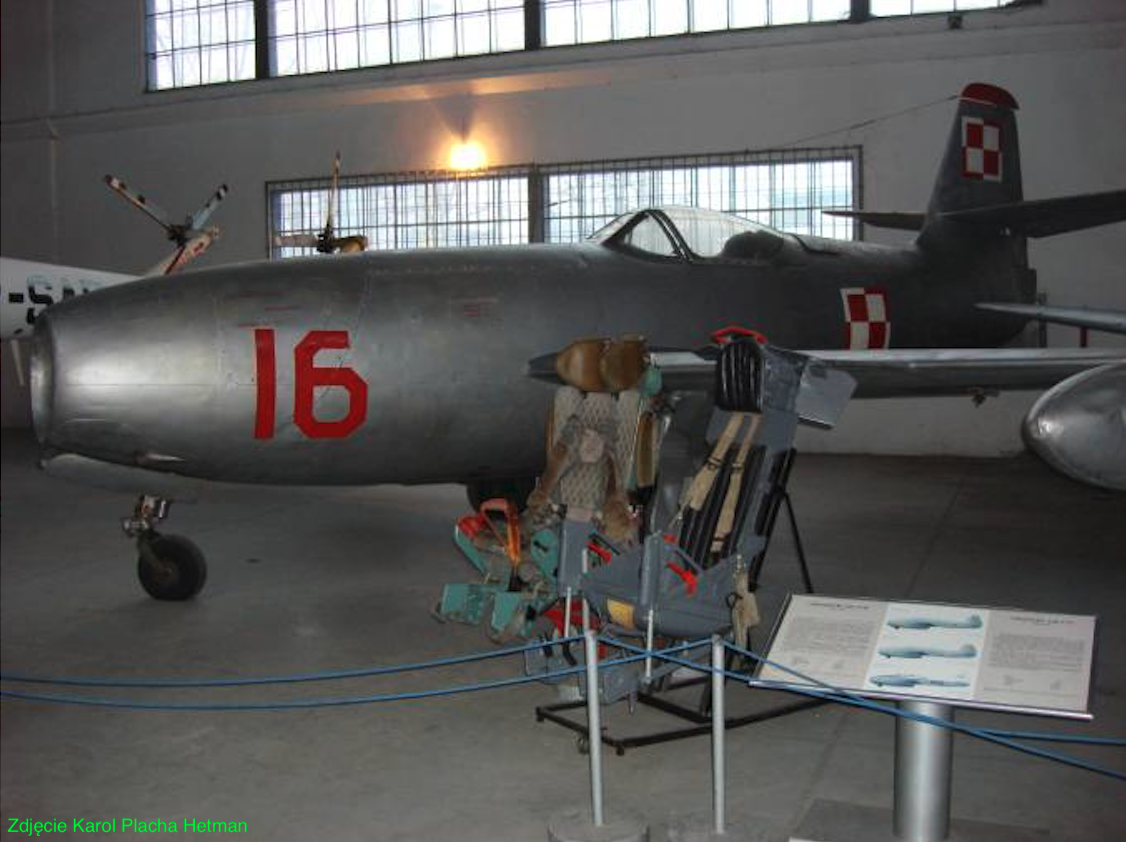
On the eve of the parade, after training and restoring the combat readiness of the planes, a decision was made to seal the fuel service tanks in all (15) Yak-23 planes taking part in the parade. For this purpose, technicians were instructed to install seals on the filler throats. Since there were no holes or other fasteners to thread the wire through, technicians were instructed to drill holes in the cap and throat. One of the technicians, Corporal Wiatrowski, operating the plane, 2nd Lt. J. Radonia did it incorrectly, resulting in damage to the tank. Inadvertently, the drill slipped lower and a hole was created in the tank. A big scandal broke out. A commission was appointed, there were interrogations and reports. A team of the best specialists was organized to repair the damage. After working all night long, the fault was repaired, the aircraft was assembled and subjected to several ground tests. This was not the only unexpected situation related to this first parade of Yak-23 aircraft.
On July 22, 1951, the fate of the air parade was uncertain from the very morning due to unstable weather. However, as the departure time approached, the weather improved a little and the decision was made to start the flights. The flight of planes was to take place in a grouping of columns of various types of aviation over Bank Square, which the communists renamed Felix Dzerzhinsky Square. The fighter aviation group using the new Yak-23 aircraft was to fly last and constitute the strongest accent of the entire flight. The leader of the column of trios was the commander of the 1st PLM Soviet, Lieutenant Colonel Bystrow. Already during the arrival at the city limits, it turned out that incorrect navigation calculations were made or the leader made a mistake and did not maintain the prescribed pilot regimes, as a result of which a group of turbojet aircraft flying at a speed of about 500 km/h overtook the Il-10 attack aircraft. A maneuver had to be made quickly to save the situation. Bystrow, after warning, lowered the flight of his trio by 100 meters. Behind him, all other Yak-23 planes performed a similar maneuver. As a result, the jet planes attacked the attack planes exactly over the Square, but flying 100 meters lower. All viewers were convinced that this was an intentional effect. Everything ended well and the planes returned to the airport in Bemowo without any incidents.
During this parade, MiG-15 fighters were also shown in the air for the first time in Poland. These planes were piloted by Soviet pilots. It is estimated that about 200,000 spectators watched the parade.
Aviation Day show. August 26, 1951.
On the occasion of the aviation holiday on August 26, 1951, the Yak-23 aircraft was shown in detail for the first time to the public. The show was organized over the Okęcie airport. An array of Yak-23 aircraft flew among the demonstrated aircraft, and at the end of the shows, Major Stanisław Tanana, Major Stanisław Więcek and Captain Kazimierz Tanana performed a team demonstration of higher pilotage on these aircraft.
The show in Warsaw was watched by many thousands of viewers, and similar events were organized in Łódź, Lublin, Olsztyn and Białystok.
MiG-15 planes in the 1st PLM. 1951.
September 1951 was significant for the 1st PLM. The regiment was the first in Poland to achieve combat readiness using turbojet-powered aircraft.
At the beginning of August 1951, as planned, by DWL Order No. 064/org, the formation of the next 13th PLM in the 5th DLM began. The base became the cadre of the 1st PLM. Pilot Major Stanisław Więcek was appointed as the commander of the 13th PLM, and as squadron commanders: captain pilot Kazimierz Tanana, pilot Lt. Wiktor Iwonia, pilot Lt. Bolesław Smolik. On August 9, 1951, 13 Jak-23 aircraft No. 713, 715, 718, 723, 724, 725, 801, 810, 819, 820, 905, 909, 1002 and a Jak training aircraft were transferred to the new regiment from the 1st PLM. -17 W No. 3120127.
This transfer of Yak-23 aircraft was related to the order to switch the 1st PLM to MiG-15 / UTI MiG-15 aircraft. At the beginning of November 1951, 1 PLM had 30 MiG-15 aircraft, 2 UTI MiG-15 aircraft and not a single Yak-23 in stock. All remaining Yak-23s were transferred to the 2nd PLM.
In 1951, the 1st PLM was the first in the country to complete complete rearmament and training for jet aircraft. The next year, 1952, the regiment spent on intensive training of new pilots who benefited from the richest experience of pilots from the unit in Bemowo.
1 PLM received PZL Lim-1 aircraft. 1952.
In Mielec, in mid-1952, serial production of license MiG-15 aircraft was launched under the name Lim-1 (License Fighter). The first batch of aircraft consisted of 6 units and was made of parts delivered from CCCP. The planes were built as part of crew training. The planes received factory numbers from 1A 01-001 to 1A 01-006. In September 1952, these planes were handed over to the army and delivered to the airport in Bemowo. Here, a series of flight tests were performed on them to detect any errors and to introduce some modifications. Subsequent Lim-1s were already delivered to other air units. At the end of 1952, the 1st PLM had reached full capacity with 36 MiG-15 / Lim-1 aircraft and 2 UTI MiG-15 aircraft.
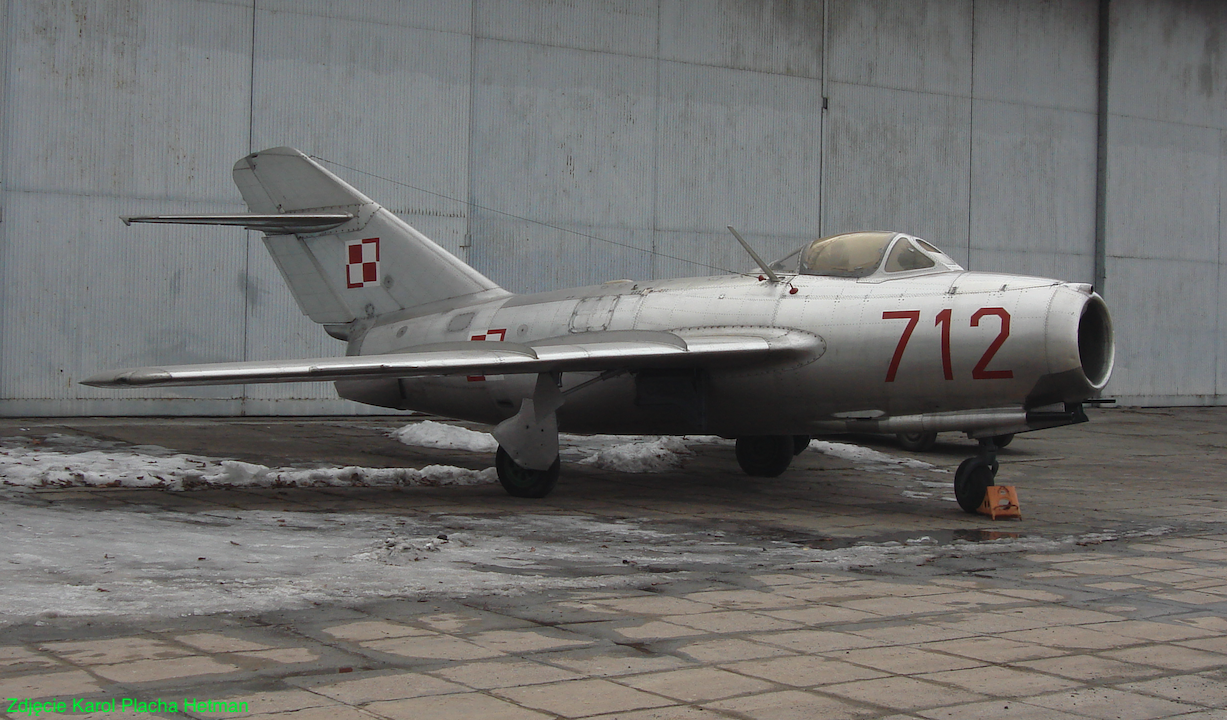
Air show. July 20, 1952.
On July 20, 1952, an air show featuring piston and jet aircraft was organized at the Warsaw Okęcie airport. The 1st PLM from Bemowo took part in the shows once again, demonstrating MiG-15 fighters in the air with Polish crews.
The flight of Zlin-26 planes was also shown, in a formation forming the letters ZMP (communist organization - Polish Youth Union). Leader; Michał Goszczyński, Henryk Kozłowski, Edward Kowalczyk. There was also a team acrobatics show on ten Mucha gliders and a mass landing of parachute jumpers.
Flight safety.
The rapid pace of training of new, young pilots for modern MiG-15 / Lim-1 aircraft, combined with a small number of two-seat versions, led to a deterioration of flight safety. In April and May 1952, there were two MiG-15 plane crashes, and in the second half of the year, two more Yak-23 plane crashes occurred in other air units. The training in the 1st PLM, which was a combat regiment, was insufficient. Therefore, in 1951, in Radom, next to the school in Dęblin No. 4, OSL (Officers' Aviation School) No. 5 was established, with a richer curriculum and a 3-year study period. Its first graduates were promoted in 1953.
However, perhaps a more important matter was the establishment of the 62nd PLM-Szk at the Poznań-Krzesiny airport, where most of the UTI MiG-15 training aircraft were gathered. Now each newly promoted fighter pilot, before joining a combat unit, underwent a training cycle in Krzesiny. In a word, the 1st PLM no longer received untrained pilots, but pilots with a specific, approximately 30-hour flight on MiG-15 / UTI aircraft.
Aviation Institute. 1953.
The introduction of modern turbojet-powered fighter aircraft into Poland's arms required a great effort from the entire Polish state. The General Staff of the Polish Army saw the need to create an Aviation Research Station that would deal with solving problems related to the operation of new flying equipment. The commencement of mass production of Lim-1 fighters at least doubled these problems. In these conditions, the creation of an Aviation Research Station turned out to be too modest an initiative. After long discussions conducted in the 8th Department of the General Staff of the Polish Army, a decision was made to establish the Air Force Scientific and Research Institute (INBWL). The legal basis was organizational order No. 042/org. Minister of National Defense of June 17, 1953. Hangar No. 6 at the Bemowo airport became the temporary seat of the Institute.
The main topic of the Institute's work is the improvement of combat readiness and flight safety. Engine test benches were established. Problems related to the introduction of Lim-1 fighters into service became a real training ground for the Institute. It was then necessary to explain many new phenomena accompanying flights at subsonic speeds. The results of this work are included in the brochure entitled – “Some peculiarities in the flight of the Lim-1 aircraft”, which was very helpful to pilots and technical services.
In 1953, the first tests of Polish tires and brake pads for Lim-1 aircraft were carried out. In the summer of 1953, flight tests began at the Institute as State Control Tests of serial Lim-1 aircraft. They became a practical test of the developed methods and measuring, on-board and ground equipment.
On March 18, 1954, by order of the Minister of National Defense, the Institute (INBWL) received the status of a scientific institution. At the same time, it moved to new facilities at Ksiącia Janusza Street in Warszawskie Koło. We wrote about it because it was starting to get crowded in Bemowo, which is not conducive to the proper performance of tasks by the 1st PLM.
On December 28, 1953, by order of the Ministry of National Defense, the 1st PLM received the honorary name "Warsaw". This fact is even more important when we consider that only the 4th PLSz from Bydgoszcz received its own name "Kraków".
On June 2, 1954, by order of the Ministry of National Defense, the title and badge of the Wyborowa Crew were introduced in aviation. This was the result of the introduction of competition in aviation. The first such titles and badges were won by pilots from 1. PLM Warszawa. The visible distinguishing feature of the title was a red lightning bolt painted on the fuselage of the plane.
Also in 1954, 1. PLM "Warszawa" took part in air shows and parades. On July 22, 1954, a parade was organized in Lublin with the participation of military aviation and landing troops on the occasion of the 10th anniversary of the Polish People's Republic. 1. PLM Warsaw showed MiG-15 planes. On August 29, 1954, shows performed by sports and military pilots were organized in Łódź. Planes from 1. PLM Warszawa also took part in this show. This show was watched by 200,000 people.
At the end of 1954, the first PZL Lim-2 fighters arrived at the 1st PLM. The next aircraft of this type were delivered to the unit in May and June 1955, and by the end of 1955, the Regiment no longer had MiG-15 and Lim-1 aircraft in stock. All planes were Lim-2.
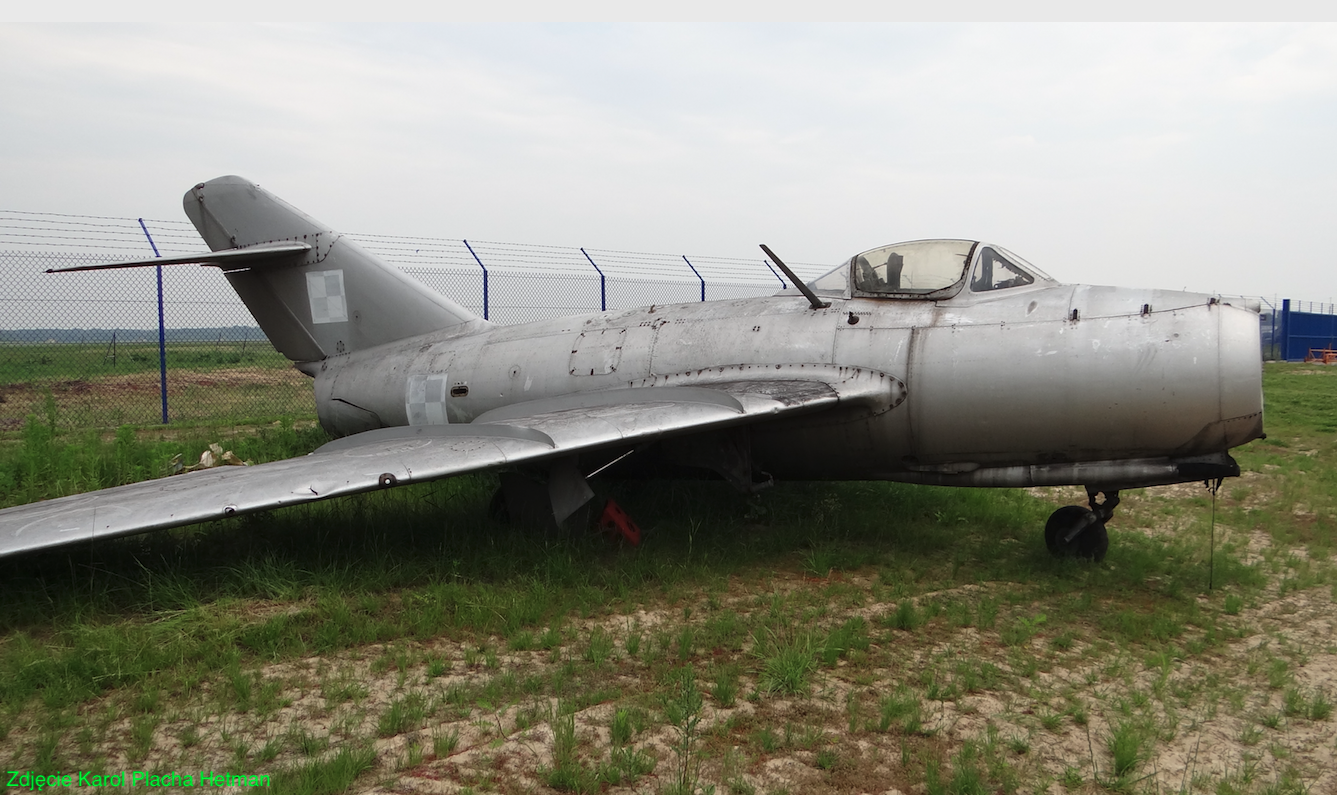
MiG-17 PF and the 21st Independent Fighter Squadron. 1955 year.
As soon as the Korean War ended, the situation in the world became heated again in 1955. Germany was admitted to NATO. Moscow's response was to establish the Warsaw Pact. Following this, Moscow decided to further modernize its satellite armies. In the second half of 1955, the first batch of 12 MiG-17 PF fighters was delivered to Poland. These planes had on-board radar sights that ensured the interception of targets in all weather conditions.
In 1955, a group of selected pilots went to CCCP to train for the new MiG-17 PF aircraft. This group included pilots; captain Czajka, Lt. R Operacz, Lt. S Radziejowski, Lt. S Nyc. The training took place in Lipetsk and Taganrog. After returning to the country, the 21st Independent Fighter Squadron was created at the Bemowo airport using these pilots and MiG-17 PF aircraft as part of the Warsaw Pact. The interception unit operated at 1. PLM Warszawa. Capt. was appointed commander Czajka.
Meanwhile, the second group of a dozen or so pilots started training in Lipetsk on a one-year course for MiG-17 PF aircraft. They were; S Wdowczyk, H Michałowski, S Kowal, M Polech, Czesław Tanana, Garczyński, Graczyk, Kozik, Skibicki, Lewiński, Padlewski, Czajkowski, Zieleziński. The following year (1956), the third group of 9 pilots underwent training at CCCP. They were there; W Hermaszewski, A Dobrzeniecki, T Matras, S Zaniewski.
The 21st Independent Fighter Squadron was incorporated into the structures of the 1st PLM in 1957.
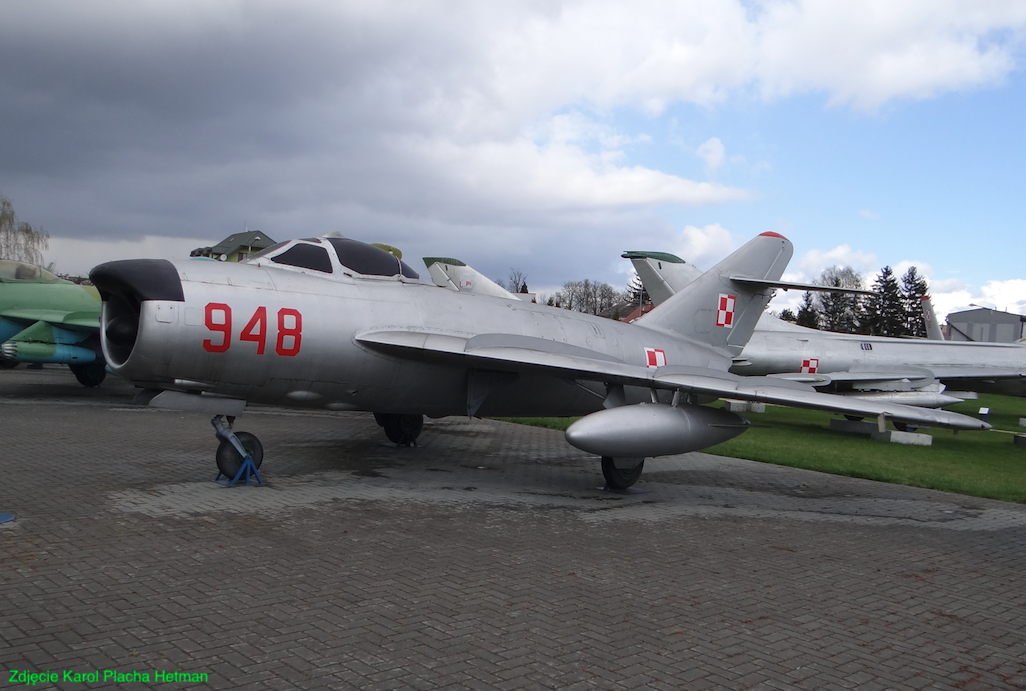
1 PLM. 1956.
The pilots of the regiment were among the creators of many new evolutions and particularly difficult pilot formations on turbojet-powered aircraft. During this period, many of them participated in numerous air shows. Already in 1956, Capt. Zygmunt Dębowski, captain Jerzy Figurski and Capt. Ryszard Grundman was the first pilot to perform higher pilotage figures on jets as a team. This team took part in shows over the Okęcie airport, and then in air shows in the GDR in Cottbus and Junchwalde. One of the Soviet generals highly appreciated this show, saying: "It's not flying anymore, it's virtuosity."
In the following years, "Trójka" expanded into "Five", "Delta" (6 planes), "Nine" and "Thirteen". For many years, the team was amazed by its incredible flight precision, complexity and beauty. Numerous pilots of the regiment took part in 1959 and 1960 in the famous field of 64 fighters.
In 1956, license production of the MiG-17 was launched in Mielec under the designation Lim-5. To begin with, a trial series of three machines numbered 1C 00-01 to 1C 00-03 was built. On November 28, 1956, these machines were handed over to the army and moved to the airport in Bemowo. And again, this airport became a place for training Polish pilots for this type of aircraft. In May 1957, these planes were officially adopted by the 1st PLM.
In July 1956, 1. PLM Warsaw received a banner funded by the State Council.
Already in 1956, final decisions were made to transfer the 1st PLM Warsaw and the 21st Independent Pursuit Squadron to Mińsk Mazowiecki. In July 1957, the regiment was finally transferred to the airport in Janów near Mińsk Mazowiecki. In the fall of 1957, the 3rd Squadron of the 1st PLM Warsaw became the nucleus of a new fighter aviation regiment in Babimost, designated as the 45th PLM.
In April 1960, a number of (4) Lim-5 P fighters were added to the Regiment's inventory. In July 1960, these and other planes from the Regiment took part in an air parade over the fields of Grunwald.
Mińsk Mazowiecki airport.
A new airport for 1. PLM Warszawa was built east of Warsaw at a distance of approximately 40 km and east of Mińsk Mazowiecki at a distance of approximately 4 km. The town of Janów on the national road No. 2. The airport is located at the geographical coordinates 52.11 N 21.39 E, at an altitude (elevation) of 184 m. The airport has one runway with a concrete surface, measuring 2,500 m x 40 m, which has orientation 09/27, i.e. almost perfectly east-west. Throughout its existence, from 1957 to 2000 and beyond, the airport served only military functions.
MiG-21 for the 1st PLM "Warszawa".
1 PLM "Warszawa" from Mińsk Mazowiecki was one of the first regiments to receive MiG-21 aircraft. On September 29, 1961, the first MiG-21 F-13 fighter aircraft no. 741217 nb 1217 was imported to Poland in great secrecy and placed in Modlin, because the Aviation Training Center was organized there. In November 1961, the first group of 16 (15) pilots was sent to CCCP to be trained for this type of aircraft. This group included five pilots from the 1st PLM "Warszawa" from Mińsk Mazowiecki. The first were Major Edmund Bogusz and Capt. Ryszard January. These pilots made their first flights on the MiG-21 F-13 in Krzesiny in the 62nd PLM.
We received another 8 MiG-21 aircraft in September 1962, and the training of another group of selected pilots from combat regiments began. This group also included pilots from Mińsk Mazowiecki. The first supersonic planes arrived in Mińsk Mazowiecki in mid-September 1963, almost simultaneously with the 62nd PLM and 11th PLM. These were 6 MiG-21 F-13 units, which were registered with the 1st Squadron.
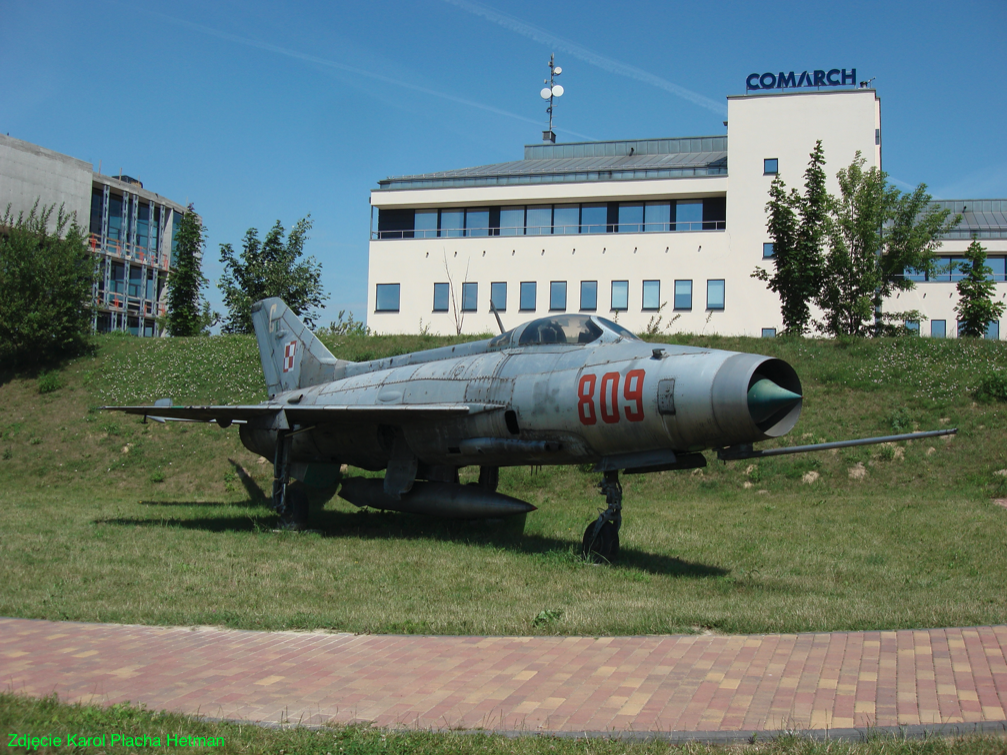
In 1964, the regiment received the first MiG-21 PF machines equipped with RP-21 radar stations. By the end of 1964, the Regiment already had 8 MiG-21 PF aircraft. These aircraft replaced the MiG-17 PF and MiG-21 F-13 previously used in the regiment, which were transferred to other units. Thanks to the rotation of equipment, mainly from the 11th PLM, in 1965, the 1st Squadron of the 1st PLM had 12 MiG-21 PF and 2 MiG-21 U aircraft. In the fall of 1965, 16 pilots from the 2nd Squadron began training for supersonic aircraft . On June 30, 1966, the first disaster involving a MiG-21 (PF) aircraft occurred in the Regiment. Unfortunately; pilot lieutenant Władysław Betka died.
As it turned out, MiG-21 PF aircraft remained in the regiment for an extremely long time, until 1989, when they were replaced by MiG-21 M aircraft from the liquidated regiment from Goleniów.
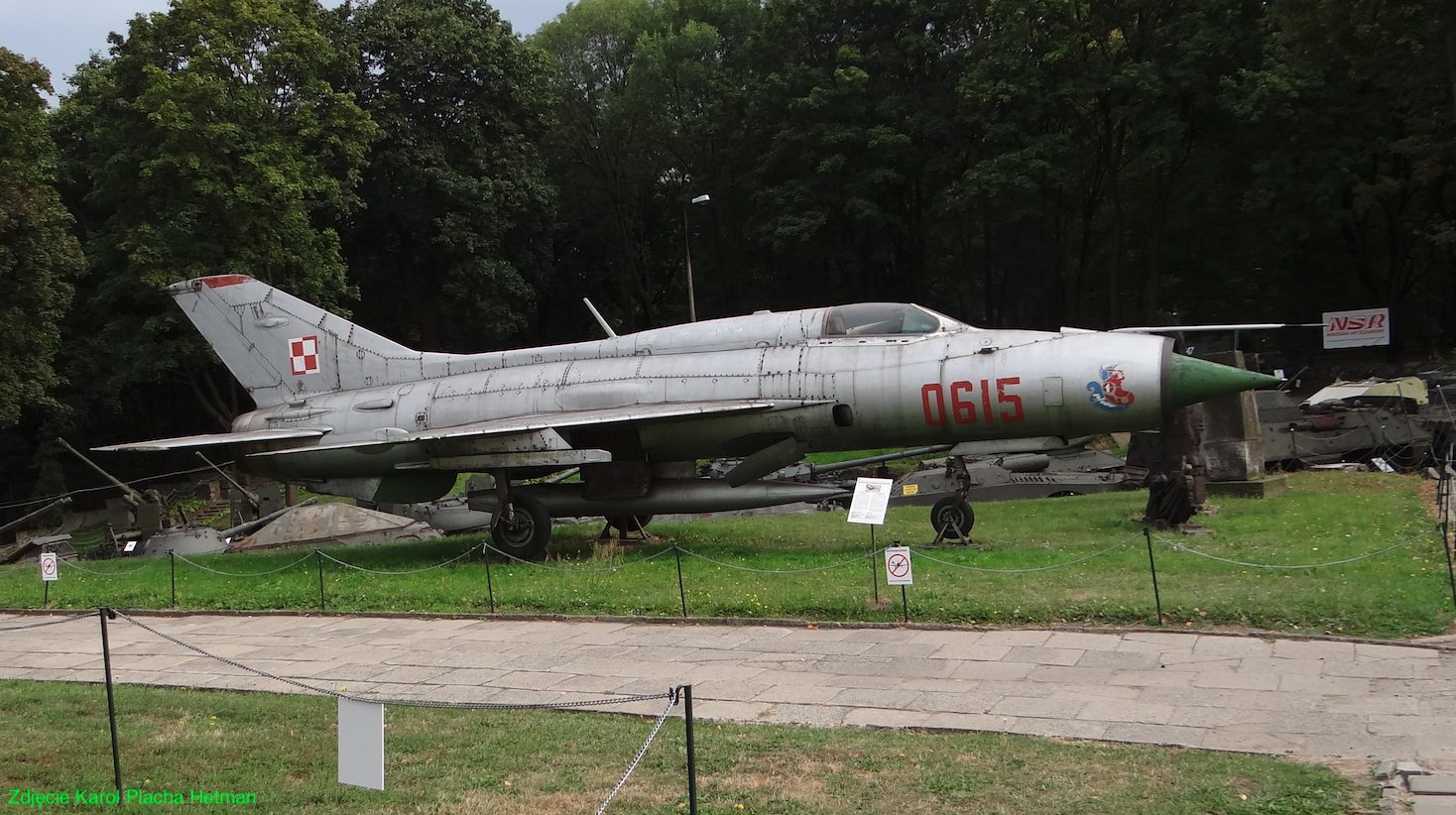
On May 15, 1966, the Regiment was reformed into a new position No. 6/461, resulting in the creation of the 22nd Flight Command Squadron and the 56th Security Battalion. In 1966, the Regiment, together with pilots from the 3rd PLM, as part of the celebration of the 1000th anniversary of Poland, formed a group called Grot-Centrum consisting of 16 MiG-21 PF machines. In 1968, designated crews of the Regiment engaged in guided missile firefights at the CCCP training ground. In January 1971, a batch of 10 MiG-21 PF aircraft from the disbanded 13th PLM in Łęczyca was accepted into service. In the fall of 1971, aviation competitions were resumed at the airport in Mińsk Mazowiecki, this time for the title of Air Combat Champion. In the 1960s and 1970s, the unit moved several times to the alternate airport in Szczytno due to renovations in Mińsk Mazowiecki; Szymany airport. At the end of the 70s, the Regiment took over 11 MiG-21 PFs from the 39th PLM. Then in 1982, another 6 MiG-21 PF aircraft from other units. During this time, 12 pilots were trained on MiG-21 PFM aircraft.
In 1983, after a two-year break, the Utility and Combat Aviation Competition was resumed for the Air Combat Champion. Second place went to Capt. Jerzy Moryc from the 1st PLM. In 1987, in such a team competition, the team from the 1st PLM took first place. In the 1980s, the main training was aimed at combating single and group air targets at low altitudes in cooperation with air defense missile means in the conditions of enemy fighter and electronic protection.
In 1988, as a result of the disbandment of the 39th PLM, all remaining MiG-21 PF aircraft were taken over by the 1st PLM, which thus had 36 MiG-21 PF and 7 MiG-21 U units in stock. In the following years, 2. MiG-21 M, PFM planes appeared in the squadron, because the 1st Squadron received the MiG-29, and the MiG-21 PF planes were canceled in 1989.
In February 1989, in the CCCP area, operating from the airport in Baranowicze, the 1st PLM together with a Soviet unit performed joint exercises. One of the main tasks was to fire S-5 missiles at ground targets.
MiG-29 and socio-political changes. 1989.
The second half of the 1980s marked the beginning of a major crisis in the air force, the end of which was still in sight in 2000. In these conditions, it was decided to at least slightly improve this state of affairs and Poland decided to purchase a minimum number of the only MiG-29 battlefield (front) fighters available to us. In February 1989, the Regiment carried out a selection of flying personnel for training in new aviation technology. Twelve pilots and a group of technical and navigation support personnel were selected and sent to Frunze at CCCP. The training was conducted between March and May 1989.
By purchasing MiG-29 aircraft, Poland became the 10th country in the world to use this type of fighter. The first 4 MiG-29 machines (9.12) and 3 MiG-29 UB planes appeared in Poland at the turn of July/August 1989. (July 1, 1989). They were placed in Mińsk Mazowiecki in the 1st PLM "Warszawa". MiG-29 serial numbers (9.12) ns; 35070, 35111, 35114, 35115, MiG-29 UB ns; 14615, 14664, 14670.
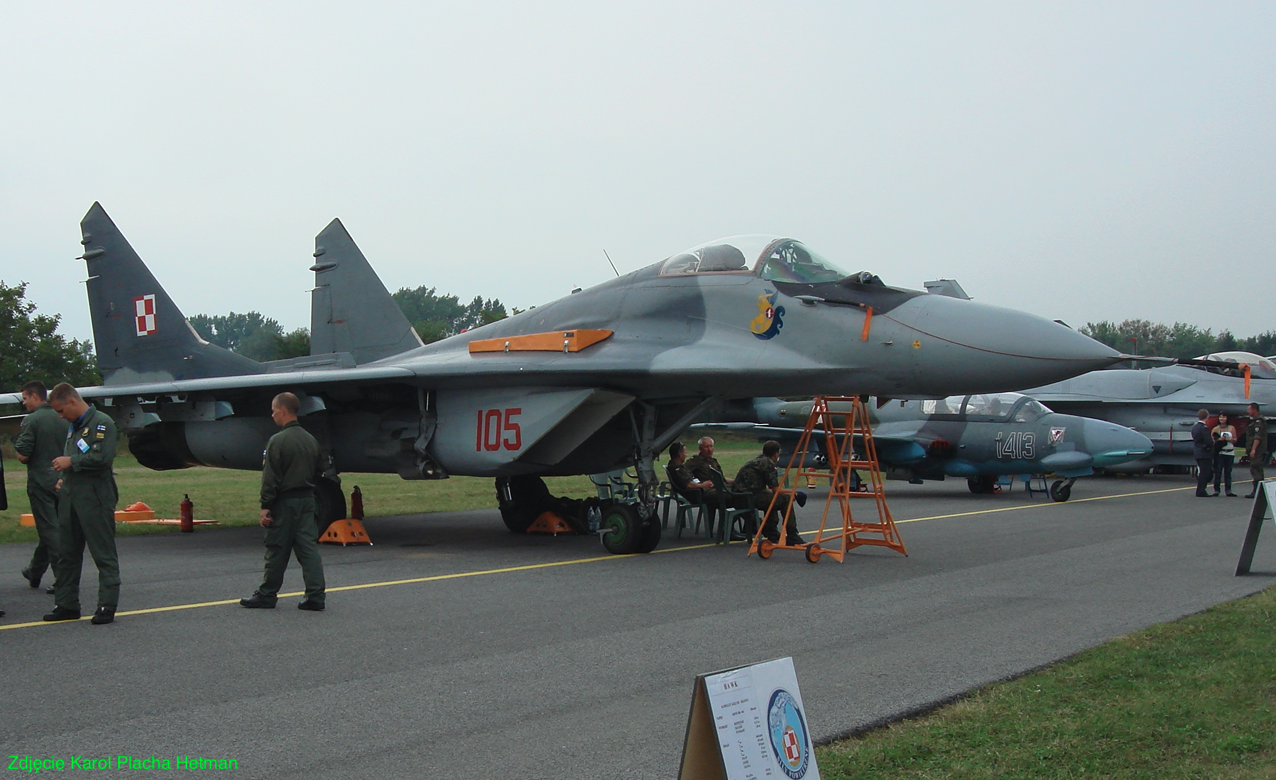
Another 5 MiG-29s (9.12 A) arrived in Poland on October 2, 1990. Serial numbers; 26365, 26367, 26383, 26389, (?). They were flown by Soviet pilots. They were accompanied by an An-12 transport plane with a technical team. Only it had the right to operate the planes until they were officially handed over to the Polish side on October 30, 1990. The planes were brand new and equipped with an RS-2 M radar station.
In total, these 12 machines allowed the 1st Squadron to be rearmed, but they were a symbolic force and could not re-evaluate the military potential. The 2nd Squadron was equipped with MiG-21 M aircraft based from Goleniów, replacing the MiG-21 PF.
The first Polish instructor pilots were trained at CCCP. The first ones include; captain pil. engineer Marian Zięba, lieutenant pilot Eng. Jacek Wojtaszczyk, lieutenant pilot engineer Wiesław Rec, lieutenant pilot engineer Waldemar Łobowski. The pilots of the regiment mastered the technique of flying on the new equipment in record time and masterfully.
In 1989, Polish pilots of new fighters said that changing from MiG-21 to MiG-29 was like changing from a small Fiat to a Mercedes. It was the first time they had received a fighter with such a large excess thrust. Capable of intercepting from a distance of 100 km. It is very difficult to put the plane into a spin (it was even said that it is impossible), but it is also very difficult to get out of it. Excellent visibility from the cab. The pilot receives more precise information. Crew safety has increased dramatically.
On January 13, 1992, after almost 3 years of basic and tactical training, the 1st squadron of the 1st PLM "Warszawa" from Mińsk Mazowiecki began duty in the Polish air defense system. Due to the critical location of Mińsk Mazowiecki, as the closest base to the eastern border, and the lack of warning means over the eastern border, the MiG-29s were placed on duty in a manner unusual for Polish Air Force regiments, i.e. they are ready to take off 24 hours a day. The Sejm of the Republic of Poland demanded such a decision. Over a 3-year period, several live firing exercises with cannons and missiles were carried out at the Ustka naval training ground.
The introduction of new aircraft coincided with social and political changes in Poland. Thanks to this, aviation began to return to cultivating the pre-war aviation traditions of the 1st Aviation Regiment. New badges, stickers and patches referring to proud traditions have appeared.
The airport in Janów has become the place of many foreign visits at various levels, this time from all over the world. Their permanent element was a pilot show on the MiG-29 performed by Pilot Major H. Chołuj and Pilot Major J. Wojtaszczyk. Particularly close contacts concerned the military cooperation of Polish aviation with the aviation of Western countries. The most fruitful example is the conclusion of Polish-French cooperation. This took place in June 1993, during the visit of the 1st PLM "Warszawa", to the 102nd Air Base in Dijon - Longvic. Our pilots in the presence of the Chief of the General Staff of the Polish Army, Lt. Gen. Tadeusz Wilecki and the WLIOP commander, Maj. Gen. Jerzy Gotała on June 14-16, 1993, they stayed in Dijon. For the first time in practice, Poles had the opportunity to confront their knowledge, piloting skills and machine capabilities with the previously foreign Western model. In the fall of 1993, the French visited Mińsk Mazowiecki with two Mirage 2000 aircraft. In turn, in 1994, our MiG-29s visited the base of the 2nd French fighter aviation squadron in Dijon.
In mid-June 1993, the 1st PLM took over the historical heritage of the aviation units of the Second Polish Republic and the name of Brigadier General pilot Stefan Pawlikowski.
More MiG-29 planes. 1995 year.
In the first half of the 1990s, the Czech Republic put its MiG-29 fighters on sale, 10 of them. The Polish government took advantage of the opportunity and acquired these machines at the turn of December 1995 and January 1996. The transaction consisted in exchanging the machines for 11 copies of the new PZL W-3 Sokół helicopters. The symbolic handover of the machines took place on February 19, 1996, in Mińsk Mazowiecki. From that moment, the 1st PLM had 22 MiG-29 aircraft in stock (still the only one in the country until MiG-29 aircraft were acquired from Germany).
On December 23, 1995, at the airport in Mińsk Mazowiecki, the ceremony of taking over the leadership of the Polish Army by President Aleksander Kwaśniewski (a communist) took place.
In 1998, the Regiment joined the 2nd OPK Corps as a unit. The commander of the 2nd OPK Corps, Brigadier General Pilot Jerzy Konieczny, was present at the change of command ceremony. In March 1998, as part of the practical implementation of the provisions of the Vienna Document, an OSCE delegation visited the Regiment. In the summer of 1998, the Regiment took part in coalition exercises as part of the Partnership for Peace program - Cooperative Chance-98 and Amber Express-98. On March 1, 1999, the first 4 MiG-29 aircraft adapted to perform tasks as part of the NATO Immediate Reaction Force and 6 pilots trained in this field were demonstrated at the airport in Mińsk Mazowiecki. In mid-March 1999, the main military ceremonies related to Poland's admission to NATO structures took place at the airport, and the planes began combat duty as part of the allied forces.
January 1, 2000.
On January 1, 2001, as a result of the restructuring of the Air Force and Air Defense, two units were established in place of the 1st PLM: - 23rd Air Base - a logistics unit that took over the economic property of the 1st PLM and the 1st Tactical Aviation Squadron - a line unit , which took over the traditions of the 1st PLM.
Aircraft used by 1. PLM:
Yakovlev Yak-1, Yakovlev Yak-9, Polikarpov PO-2, Ilyushin Il-2, Yakovlev Yak-17 W, Yakovlev Yak-23, Mikoyan and Gurevich MiG-15, WSK Lim-1/2, Mikoyan and Gurevich MiG- 17 PF, WSK Lim-5, WSK Lim-5 P, Mikojan and Guriewicz MiG-21 F-13 / PF / PFM / M / U, Mikojan and Guriewicz MiG-29 9.12 / UB, PZL TS-8 Bies, PZL TS -11 Iskra, PZL Mi-2, PZL Antonow An-2.
Commanders:
Capt. pilot Vasyl Gashin: 23/03/1945 - 24/10/1945. Lt. Col. Pilot Tadeusz Wicherkiewicz: 24/10/1945 - 20/12/1947. Major pilot Michał Bujewicz: 20/12/1947 - 15/05/1949. Lt. Col. Pilot Wasyl Bystrow: 15/05/1949 - 15/02/1951. Major pilot Tadeusz Krepski: 16/02/1951 - 11/05/1953. Major pilot Stefan Płoszański: 12/05/1953 - 7/10/1955. Lt. Col. Pilot Lucjan Kałkus: 8/10/1955 - 20/01/1963. Major pilot Stanisław Mielczarek: 22/01/1963 - 27/06/1964. Maj. pilot Ryszard Grundman: 28/06/1964 - 11/08/1973. Major pilot Roman Harmoza: 11/08/1973 - 21/12/1977. Lt. Col. Pilot Henryk Agnieszczak: 22/12/1977 - 2/01/1984. Lt. Col. Dipl. pilot Czesław Biszowiecki: 2/01/1984 - 10/10/1988. Lt. Col. Dipl. pilot Zenon Kida: 8/10/1988 - 11/01/1991. Lt. Col. Dipl. pilot Lech Majewski: 11/01/1991 - 30/09/1993. Lt. Col. Dipl. pilot Sławomir Dygnatowski: 30/09/1993 - 15/02/1998. Lt. Col. Dipl. pilot Włodzimierz Usarek: 15/02/1998 - 31/12/2000.
Written by Karol Placha Hetman
